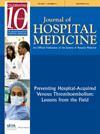Real-time symptom monitoring using electronic patient-reported outcomes: A prospective study protocol to improve safety during care transitions for patients with multiple chronic conditions
Abstract
Introduction
Adverse events (AEs) during transitions from hospitals to ambulatory settings occur in 19%–28% of cases, posing a significant threat to patient safety. Early screening for worrisome symptoms and deterioration in overall health is critical for older adult patients with multiple chronic conditions (MCCs). Clinically integrated apps that remotely monitor symptoms and collect patient-reported outcomes (PROs) can predict AEs when combined with electronic health record (EHR) data. This innovative intervention may enable more timely detection, escalation, and mitigation of harm from AEs for patients with MCCs during transitions.
Methods
This remote monitoring intervention leverages evidence-based frameworks for care transitions and health technologies. We will develop and validate a prediction model of postdischarge AEs using validated symptoms, PRO questionnaires, and EHR data. Existing digital infrastructure will be adapted to facilitate remote monitoring. We will employ a user-centered approach to identify patient and clinician requirements to guide the design and development of our intervention. Interoperable data exchange standards and application programming interfaces will be utilized to integrate the intervention with vendor EHRs and patient portals. A randomized controlled trial will be conducted to compare the effect of our intervention versus usual care on postdischarge AEs in MCC patients transitioning from the hospital. A mixed-methods evaluation will be performed to generate best practices for disseminating this intervention at institutions with different EHRs.
Discussion
A patient-centric, digitally enabled surveillance strategy that monitors symptoms and electronic PROs, educates patients about risks, and ensures communication with clinicians has the potential to transform care for patients with MCCs during transitions.






 求助内容:
求助内容: 应助结果提醒方式:
应助结果提醒方式:


